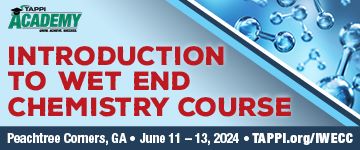 Search
Search
Use the search bar or filters below to find any TAPPI product or publication.
Filters
Content Type
Publications
Collections
Journal articles

Magazine articles

From biorefineries to bioproducts: conversion of pretreated pulp from biorefining streams to lignocellullose nanofibers, TAPPI Journal April 2019
ABSTRACT: This study investigates the use of pretreatment and enzymatic hydrolysis side streams and conver-sion to lignocellulose nanofibers. We used a steam-exploded and partial enzymatic hydrolyzed hardwood pulp and an organosolv pretreated softwood pulp to prepare lignocellulose nanofibers (LCNF) via microfluidization. The ener-gies applied on fibrillation were estimated to examine the energy consumption levels of LCNF production. The ener-gy consumptions of the fibrillation processes of the hardwood LCNF production and the softwood LCNF production were about 7040-14080 kWh/ton and 4640 kWh/ton on a dry material basis, respectively. The morphology and dimension of developed hardwood and softwood LCNFs and the stability and rheological behavior of their suspen-sions were investigated and are discussed.
Journal articles

Magazine articles

Extensive function of green synthesized titania nanoparticles: Photodegradation of Congo red, TAPPI Journal September 2023
ABSTRACT: Several extensive research studies have explored the advantages of green templates in the synthesis of structure and morphology-controlled photocatalytic nanomaterials. This paper compares the abilities of zingiber rhizome extract (ZE) and tapioca starch extracts (TS) in modifying the surface and optical properties of titania nanoparticles (TNP) synthesized by solgel technique. The synthesized nanocatalysts were characterized using various physicochemical techniques. While zingiber (ginger) extract effectively promotes the formation of dual anatase and rutile phases, tapioca extract supports formation of the single anatase phase of titania. These two extracts were examined for the degradation of Congo red in the presence of sunlight. The photomineralization and recyclability of catalysts were evaluated through total organic content analysis. The easy recovery and reusability of zingiber and tapioca biomasses, along with good control over the growth of nanoparticles, enable them to be implicit novel green templates in the successful synthesis of photoactive mesoporous nanotitania.
Journal articles

Magazine articles

Effects of orders of addition in nanocellulose•cationic starch• colloidal silica systems for papermaking, TAPPI Journal October 2022
ABSTRACT: Two orders of addition were compared when preparing paper handsheets from recycled copy paper furnish in combination with nanofibrillated cellulose (NFC), cationic starch, colloidal silica, and cationic retention aid (cPAM; cationic polyacrylamide). Faster dewatering and higher fine-particle retention were obtained at equal optimized dosages of additives when the colloidal silica was added last, after addition of the cPAM. The same order of addition also provided a higher gain in the paper’s tensile strength. However, higher paper stiffness was achieved when the colloidal silica was instead added to the NFC, after its pretreatment with cationic starch. Results were consistent with the principle that papermaking additives added shortly before sheetforming tend to have the largest effects on drainage and retention. The results also demonstrated a sensitivity to the relative dosages of positively and negatively charged additives.
Journal articles

Magazine articles

TAPPI Journal Summaries, Paper360º July/August 2020
TAPPI Journal Summaries, Paper360º July/August 2020
Journal articles

Magazine articles

TAPPI Journal Summaries, Paper360º May/June 2018
TAPPI Journal Summaries, Paper360º May/June 2018
Journal articles

Magazine articles

Papermaking properties of bacterial nanocellulose produced from mother of vinegar, a waste product after classical vinegar production, TAPPI Journal April 2020
ABSTRACT: Bacterial nanocellulose (BNC) has gained a lot of attention in recent years due to its nano-size-derived properties. Although it is essentially chemically similar to plant-derived cellulose, it has smaller size and is enriched in free hydroxyl groups, which greatly improve mechanical properties of reinforced paper. However, although BNC has some unique features, it comes at a high price. In this paper, we introduce a new solution for BNC production. We have isolated bacterial nanocellulose directly from agro-industrial waste—mother of vinegar—and used it in the production of paper sheets. We show here that paper sheets made with the addition of only 10% bacterial nanocellulose from mother of vinegar substantially improved basic mechanical as well as printing properties of paper.
Journal articles

Magazine articles

TAPPI JOURNAL Summaries, Paper360º, July/August 2017
TAPPI JOURNAL Summaries, Paper360º, July/August 2017
Journal articles

Magazine articles

We’ve Got Good Chemistry: Innovations Papermakers Need to Know About, Paper360º March/April 2020
We’ve Got Good Chemistry: Innovations Papermakers Need to Know About, Paper360º March/April 2020
Journal articles

Magazine articles

TAPPI Journal Summaries, Paper360º May/June 2020
TAPPI Journal Summaries, Paper360º May/June 2020
Journal articles

Magazine articles

Novel thin functional coatings for paper by foam coating, T
Novel thin functional coatings for paper by foam coating, TAPPI JOURNAL April 2017






